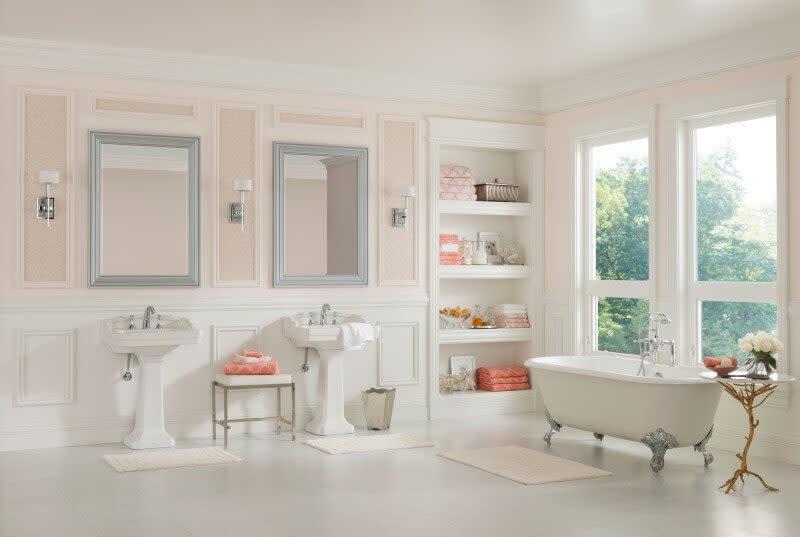Does Crown Moulding Have to Match the Baseboards?
December 15, 2020
By: The Finished Space
What’s the rule? Does crown moulding have to match the baseboards or can they be different? When it comes to interior design, there seems to be a lot of rules, and it can get overwhelming pretty quickly.
Thankfully, you know what they say about rules. They’re meant to be broken. Let’s get into everything you need to know about how to tastefully match the finishing touches like crown moulding, baseboards, and casings.
Achieve a Consistent Home Aesthetic with Interior Trim
The interior trim of a home is often an afterthought. Homeowners and designers alike are guilty of waiting to think about the trim until the end of the design. Unfortunately, they’re overlooking the value that interior trim can bring to a space.
Interior trim is a lot like a bow on a gift. While the gift can look okay without a bow, it sure looks a lot better with one. The bow can also make a dramatic difference in the appearance of the gift.
Interior trim is the same way. It can tie a whole room together or elevate it to new heights. There are a few types of trim for interiors, and we need to briefly discuss all of them before we can talk about best practices.
Crown Moulding
Crown moulding is probably what you think about first when you think about a style of trim. It’s the trim that is applied where the wall and ceiling meet.
Baseboards
A baseboard is the moulding that’s applied along the floor line at the base of the wall.
Casings
Casings are the trim or moulding around windows and doors.
Which Features of Trim Should Match?
Now that you know the trim types found inside a home, which parts of the trim should match? Does the crown moulding have to match the baseboards? Do the baseboards have to match the casings?
The quick answer to these questions is that you can mix and match your trim however you please. If you like something, don’t let any rules tell you that you can’t do it.
However, if you’re curious about what the experts have to say, the quick rule of thumb is that you want your trim pieces to complement one another, and the room. Many people simply choose the same style for all three types of trim to keep things simple.
Most experts recommend making at least two trim elements match and then have the other be consistent in color, style, size, or material to maintain a balanced look.
So, what are the options in style, color, size, and material?
Style
Today, numerous moulding styles are available from Vintage Industrial to Modern Farmhouse and more. There’s no shortage of awe-inspiring finishing touches that are available.
Ultimately, you can mix and match different styles to create the look you want. However, navigating the different styles can be challenging, so we’ve simplified the process by including the above designs as a part of our Option {M} interior moulding and door combinations. We’ve grouped all of our products by popular decor styles, so you can easily select the look you’re going for.
Color
By and large, white is the most popular color for interior trim. It looks good in almost any space and doesn’t clash with any design. If you didn’t think about trim until the very end, you can rest easy going with white trim.
However, you may want to consider off-white or cream if your room has deep dark walls, as the stark white might be too bright. White might also be too harsh in historic homes because the white will scream, “Hey, I’m new!” against all the historic elements.
Matching the baseboards and crown moulding to the wall color is an option for a unique aesthetic. Since white trim is the norm, a dark trim against a light wall color can have the same contrasting visual effect.
When it comes to color, you can’t go wrong with white or off-white, but don’t be afraid to try out other tones as well. If you go with a bold baseboard or casing color, you can match moulding elements or remain neutral and let the accent colors stand out on their own.
Size
Interior trim sizes are all based on room proportions and the style that you’re trying to achieve. Historic homes and certain architectural designs have different ratios than modern homes, so it can get really tricky.
There are many architectural mathematical formulas out there that claim to have the perfect proportions for interior trim. However, as soon as someone writes a formula, another person behind them can debunk it.
As a general rule, if your ceilings are 8 ft. high, you want to make sure your baseboards are at least five-¼ inches high. They can be larger, but any smaller can make the room look a little out of proportion.
For the rest of your trim – play around. Play with making some elements the same size. For instance, try making your crown moulding and baseboards the same size to create symmetry and uniformity. Or incorporating a larger crown moulding to give the appearance of a higher ceiling.
How to Buy Crown Moulding and Baseboards for Your Home
So, does crown moulding have to match baseboards? No Way! Ultimately, you can purchase crown moulding and baseboards for your project in whatever configuration you want.
However, if you’d like a little help choosing crown moulding and baseboards, to be confident that it will look great – Give Option {M} a try for curated trim styles and designs without the fuss.

